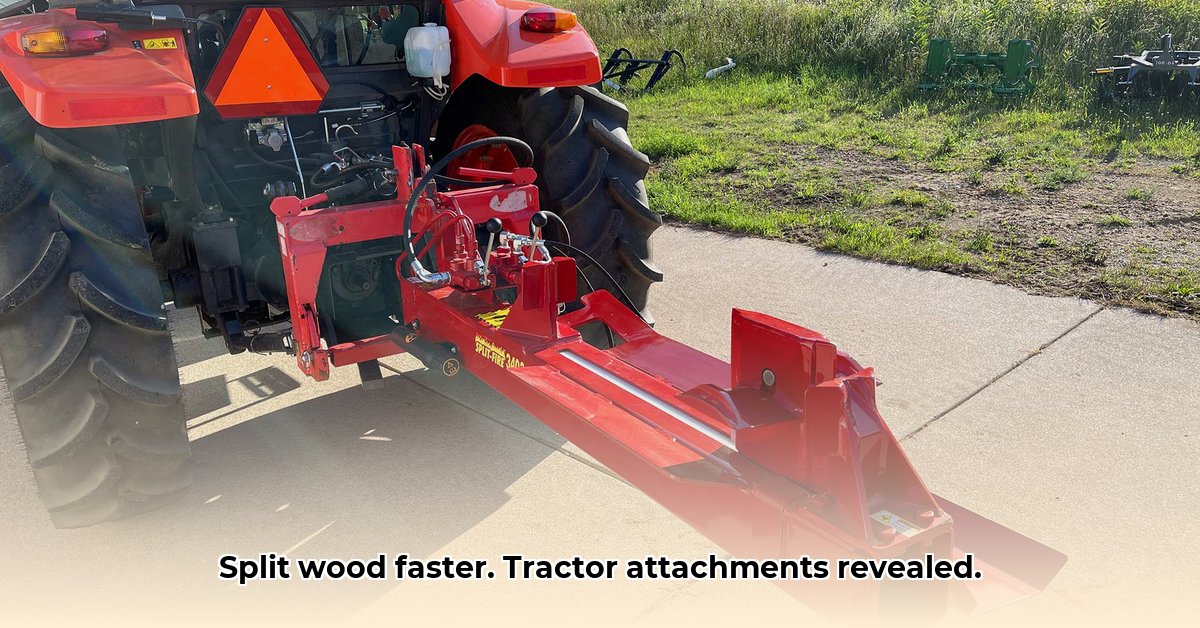
Choosing the right tractor log splitter attachment can significantly boost your firewood production efficiency. This comprehensive guide will walk you through selecting, installing, operating, and maintaining a tractor-based log splitter, maximizing your output while ensuring safety. We'll cover both 3-point hitch and PTO (Power Take-Off) models. For additional tractor attachments, check out these helpful resources.
Choosing the Right Log Splitter Attachment
Matching your tractor's capabilities to your log splitter is crucial for safe and efficient operation. Underpowering the splitter leads to frustratingly slow work, while overloading it risks serious damage to your tractor. This section will help you avoid these pitfalls.
Assessing Tractor Compatibility: A Critical First Step
Before you begin shopping, gather your tractor's specifications. You'll need three key figures from your tractor's owner's manual or data plate: horsepower (HP), hydraulic flow rate (GPM – gallons per minute), and three-point hitch capacity (for 3-point hitch models).
Horsepower (HP): This represents your tractor's engine power; crucial for PTO splitters. Insufficient HP results in slow splitting and potential engine strain.
Hydraulic Flow Rate (GPM): This determines how quickly the hydraulic cylinder operates—a higher GPM means faster splitting cycles. Low GPM leads to significantly slower operation.
Three-Point Hitch Capacity (lbs): This is the maximum weight your tractor's three-point hitch can safely handle. Exceeding this limit risks damage to your tractor.
| Tractor Specification | Importance | How to Find It |
|---|---|---|
| Horsepower (HP) | Engine power; crucial for PTO splitters and overall splitting force. | Tractor's data plate or owner's manual |
| Hydraulic Flow Rate (GPM) | Determines splitting cycle speed. Lower GPM means much slower operation. | Tractor's data plate or owner's manual |
| 3-Point Hitch Capacity (lbs) | Maximum weight the hitch can safely support (for 3-point hitch splitters). | Tractor's data plate or owner's manual |
Rhetorical Question: Isn't it essential to understand your tractor's limitations before investing in a potentially damaging log splitter?
Understanding Log Splitter Specifications: Beyond Splitting Force
While splitting force (measured in tons) is vital—determining the size of logs you can effectively split—other factors significantly impact performance and efficiency. Consider:
Cycle Time (seconds): The time to complete one splitting cycle. Faster cycle times mean greater productivity.
Wedge Type: Different wedges suit various wood types and sizes. Consider the types of wood you'll primarily be splitting.
Hydraulic System Type: Open-center and closed-center hydraulic systems have different operating characteristics; ensure compatibility with your tractor.
| Splitter Feature | Impact on Performance |
|---|---|
| Splitting Force (Tons) | Determines maximum log size and splitting power. |
| Cycle Time (Seconds) | Directly affects overall productivity; shorter is better. |
| Wedge Type | Affects efficiency and suitability for different wood types and sizes. |
| Hydraulic System Type | Impacts system compatibility and operational characteristics. |
Quantifiable Fact: A log splitter with a 10-second cycle time can process significantly more wood in an hour than one with a 30-second cycle time.
Budget Considerations: Balancing Cost and ROI
Log splitter prices vary widely. While less expensive models might seem tempting, they may lack durability or crucial features, impacting their long-term ROI. Consider the volume of wood you intend to split annually and the expected lifespan of the unit when determining your budget. A high-quality splitter, while initially more expensive, often has better ROI due to its longer lifespan and lower maintenance needs.
Installation and Operation: Safety First
Correct installation and operation are paramount for safety and efficiency. Always consult both your tractor's and the log splitter's owner's manuals before proceeding.
Installing a 3-Point Hitch Splitter
- Raise your tractor's 3-point hitch to its highest position.
- Securely attach the splitter's lower links to the tractor's lower arms.
- Connect the splitter's top link to your tractor's top link, ensuring a snug fit.
Installing a PTO Splitter
- Only after connecting the splitter, engage the tractor's PTO.
- Carefully align and connect the splitter's PTO shaft to your tractor's PTO shaft, securing it firmly.
- Thoroughly inspect all connections before operation.
Operating Your Log Splitter
- Always operate the splitter on a level, stable surface.
- Clear the area of obstructions and bystanders.
- Wear appropriate safety gear (safety glasses, gloves).
- Handle logs carefully; avoid jerky movements.
Maintenance and Troubleshooting: Extending Lifespan and Avoiding Downtime
Regular maintenance is essential for maximizing your splitter's life and minimizing downtime.
Routine Maintenance
- Regularly inspect hydraulic fluid levels; top off with the specified fluid type.
- Lubricate moving parts as per the manufacturer's recommendations.
- Inspect for leaks, cracks, or damage after each use.
Troubleshooting
- Low hydraulic fluid is the most common cause of poor performance. Address any leaks immediately.
- If the pump is suspected to be faulty, consult a qualified mechanic.
- Never attempt repairs while the splitter is connected to the tractor or the hydraulic system is under pressure.
Expert Quote: "Preventative maintenance is significantly cheaper than emergency repairs," says John Miller, Certified Agricultural Mechanic, at Miller's Tractor Repair.
Conclusion: Boost Your Wood Splitting Efficiency
By following this guide, you'll be well-equipped to choose, install, operate, and maintain a tractor log splitter effectively and safely. Remember, the right splitter, paired with proper installation and maintenance, will significantly improve your wood-splitting efficiency.